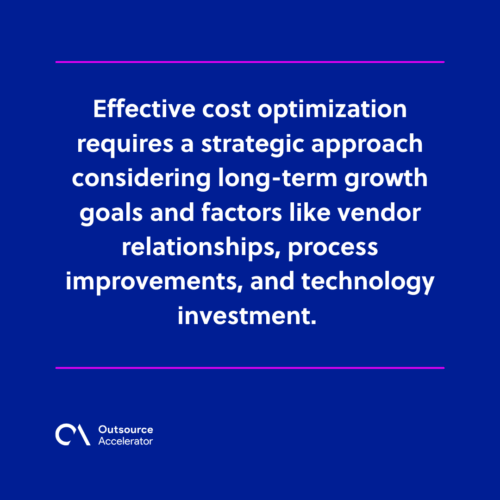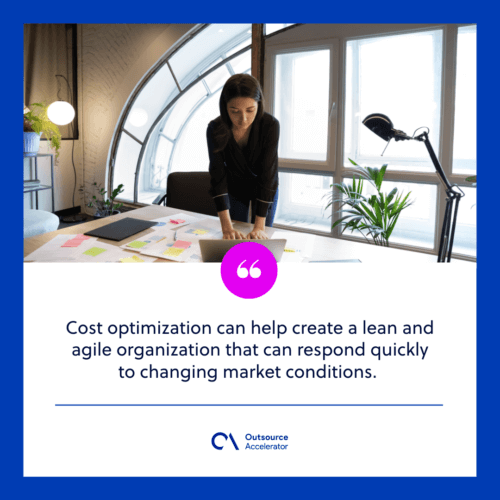11 strategies for effective cost optimization

Cost optimization has emerged as a critical factor for sustainable success. It’s no longer merely about slashing expenses but redefining how we approach business efficiency.
Whether faced with economic downturns, resource constraints, or rapid growth, mastering cost optimization is key to driving long-term viability.
This article delves into the strategies and best practices organizations can leverage to optimize costs and pave the way for sustainable growth.
What is cost optimization?
Cost optimization is a continuous and disciplined approach to reducing spending while maximizing business value.
It involves identifying sources of wasteful spending, underutilization, or low returns in an organization’s budget. Unnecessary expenses are reduced, while the company may also reinvest in new methods that will improve margins or business growth.
Effective cost optimization requires a strategic approach considering long-term growth goals and factors like vendor relationships, process improvements, and technology investment.

Difference between cost optimization and cost-cutting
Cost optimization and cost-cutting are both strategies aimed at reducing expenses within a business, but they differ significantly in their approaches and goals.
While they share the objective of improving a company’s financial health, they do so through distinct methods and outcomes.
Definition and focus
Cost optimization maximizes value and efficiency across all business aspects while optimally allocating resources. The goal is to achieve the best quality, efficiency, and cost outcome.
Cost cutting reduces expenses by eliminating or lowering certain activities, resources, or services. These cuts may impact long-term viability in exchange for short-term savings.
Approach
Cost optimization takes the following approaches:
- Identifies areas for improvement and efficiency gains
- Prioritizes value creation and long-term sustainability
- Balances cost reduction with quality maintenance
On the other hand, cost cutting involves immediate reduction of expenses without deep analysis of long-term consequences. It aims for quick financial relief and may result in downsizing, feature reduction, or discontinuation of products or services.
Quality and value
Cost optimization prioritizes maintaining or improving quality, recognizing that this leads to customer satisfaction and loyalty.
Meanwhile, cost cutting may result in decreased quality, negatively impacting customer perception.
Long-term perspective
Cost optimization takes a holistic and strategic approach to business operations, recognizing the importance of continuous improvement.
Cost cutting in the long term may hinder the business’s ability to adapt and innovate to evolving market dynamics.
11 best cost optimization strategies
Cost optimization is a strategic approach that maximizes the efficiency of resources and processes while minimizing expenses.
To achieve effective cost optimization, businesses can employ the following key strategies:
1. Streamline processes
Streamlining internal processes is crucial for identifying and eliminating inefficiencies. Businesses should regularly analyze workflows, identify bottlenecks, and restructure processes to improve productivity and reduce wasted resources.
By optimizing processes, companies can enhance overall efficiency and reduce unnecessary costs.

2. Technology integration
Integrating technology solutions can significantly enhance efficiency and reduce manual labor costs.
Automation tools, software systems, and data analytics can streamline tasks, improve accuracy, and reduce human error. Businesses can explore tools that manage inventory, automate billing, and handle routine tasks to free up employee time for more value-added activities.
3. Supplier management
Establishing strong relationships with suppliers can lead to favorable terms, discounts, and better pricing.
Negotiating contracts, bulk purchasing, and exploring alternative suppliers can reduce procurement costs. Regularly evaluating supplier performance ensures ongoing value and cost savings.
4. Resource allocation
Efficient resource allocation involves aligning resources with actual needs.
Zero-based budgeting is an approach where each expense must be justified, leading to a more accurate and controlled allocation of funds. Businesses can optimize resource utilization by focusing on essential activities and avoiding unnecessary expenses.
5. Energy and resource efficiency
Adopting sustainable practices reduces environmental impact and lowers costs. Energy-efficient technologies, waste reduction measures, and responsible resource management can lead to substantial savings over time.
These initiatives often resonate positively with customers and stakeholders, enhancing brand reputation.
6. Employee engagement
Engaged employees are more likely to contribute innovative ideas for cost savings.
Businesses can create a cost-conscious culture by involving employees in identifying inefficiencies and encouraging them to suggest improvements. Incentive programs that reward cost-saving ideas can boost engagement and productivity.
7. Lean principles
Implementing lean principles, derived from Lean Six Sigma methodologies, emphasizes eliminating waste in processes.
This includes reducing excess inventory, minimizing waiting times, and eliminating defects. By implementing lean practices, businesses can enhance efficiency and quality while minimizing costs.
8. Data-driven decision making
Leveraging data analytics enables informed decision-making. Businesses can identify trends, predict demand, and optimize supply chain operations by analyzing historical data.
Data-driven insights help in making more accurate financial projections and resource allocations.
9. Outsourcing and insourcing
Strategic outsourcing can reduce costs by leveraging specialized services without maintaining in-house expertise.
Conversely, insourcing certain functions might be cost-effective when they’re core to the business. Companies should evaluate which tasks can be outsourced to experts and which are better handled internally.
10. Continuous improvement
Cost optimization is an ongoing process. Regularly reviewing and updating strategies ensure they remain relevant and effective.
Encouraging a culture of continuous improvement allows businesses to adapt to changing market conditions and refine cost-saving initiatives.
11. Quality vs. Cost balance
While pursuing cost optimization, maintaining product or service quality is essential.
Cutting costs indiscriminately can lead to decreased quality and customer satisfaction. Striking the right balance between cost savings and maintaining quality is vital for sustainable success.
How cost optimization impacts businesses
Cost optimization can positively impact an organization in several ways. Here is how cost optimization benefits businesses:
Improved financial performance
Cost optimization can help a company achieve financial stability by reducing costs and increasing profitability.
By finding and eliminating unnecessary expenses, businesses can allocate resources more efficiently and maximize their return on investment.
Enhanced competitiveness
Cost optimization can help businesses stay competitive by enabling them to offer products and services at lower prices than their competitors.
Optimizing costs can lead to investment in innovation and expanded offerings. This increases a company’s value proposition and market share.

Increased agility
Cost optimization can help create a lean and agile organization that can respond quickly to changing market conditions.
By streamlining operations and eliminating waste, businesses can become more flexible and responsive to customer needs and market demands.
Improved customer experience
Cost optimization can help businesses invest in customer experience initiatives, such as improving product quality and enhancing customer service.
By optimizing costs and investing in these initiatives, businesses can create a better customer experience, increasing customer loyalty, retention, and advocacy.
Better employee satisfaction
Cost optimization can help create a more efficient and productive workplace, leading to increased job satisfaction and employee morale.
This can be done through investing more in employee training and development. Businesses can create a positive work environment that fosters employee engagement and retention.







 Independent
Independent




